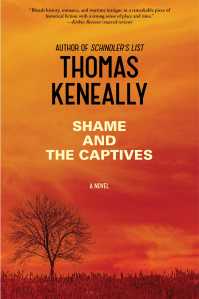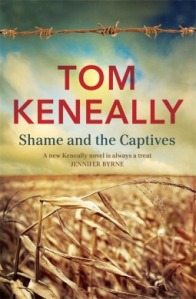 Thomas Keneally’s new novel, Shame and the Captives, is an elegantly-written, tragic exploration of the consequences of culture clash in an Australian prison-camp town during World War II.
Thomas Keneally’s new novel, Shame and the Captives, is an elegantly-written, tragic exploration of the consequences of culture clash in an Australian prison-camp town during World War II.
Keneally, the winner of the Australia Council Award for Lifetime Achievement in literature this year, is a consummate storyteller, a graceful stylist, and a prolific writer of more than 30 novels. He is best known for Schindler’s Ark, the winner of the Man Booker Prize in 1982, but my favorite is Woman of the Inner Sea, a story of a woman who starts a new life in the Outback as a barmaid after her children die in a fire and her wealthy philandering husband blames her.
 In the introduction to Shame and the Captives, Keneally explains that his novel is “a parallel account, or a tale provoked by the events” of a violent outbreak of Japanese prisoners from a prison camp in Cowra in New South Wales in Australia in 1944. (The name Cowra is changed to Gawell in the novel.)
In the introduction to Shame and the Captives, Keneally explains that his novel is “a parallel account, or a tale provoked by the events” of a violent outbreak of Japanese prisoners from a prison camp in Cowra in New South Wales in Australia in 1944. (The name Cowra is changed to Gawell in the novel.)
This dramatic character-driven novel has a huge cast. It begins with twenty-three-year-old Alice Herman, whose husband Neville has been a prisoner in Austria for two years. She leads an uneventful life on her father-in-law’s farm. When a truck drops off some Japanese prisoners to work on the road, she is excited and curious. She makes lemonade for them, and hopes some woman will be similarly kind to Neville in his prison.
Back to the kitchen she raced and fetched from a box by the dresser the remaining leftover lemons from the two trees in the informal orchard beyond th back gate. She began to slice the fruit, squeeze it out, pour the juice into jugs, go to the ice chest, chip ice off the ice blocks, put it all in the jug, mix in sugar–a reckless amount of her ration–add water from the kitchen tap with tank wigglers in it, and stir it all up. She did not want her father-in-law to come in and see her behaving like this, so it must be done briskly.
The theme of shame is explored throughout the novel. Alice is desperate, sexually-starved, and angry because she barely knew her husband before he was captured in the war. When an Italian prisoner, Giancarlo Molisano, comes to live and work on the Hermans’ farm, Alice initiates sex with him. Later, when he indicates his reluctance to continue the affair because of his loyalty to her father-in-law, she is angry, and it is clear that he is her captive.
The prison camp holds Japanese, Italians, and Koreans. Tengan, a young Japanese pilot with long lashes and wide-set eyes, is so ashamed of having been captured that he dreams of killing the guards and then committing suicide. He is one of the leaders in the camp. Many of the Japanese prisoners would rather be presumed dead than captured, and hence fail to reply to their relatives’ letters. Sakura, a professional female impersonator, shares their belief in the shame of captivity: when the time comes for suicide, she will don an appropriate costume.
The officers at the camp have deceptively simple lives. Major Bernard Suttor, the commander of Compound C, spends his free time writing his popular comic radio serial, The Mortons of Gundahah. which also distracts him from fear for his son, a prisoner in China. Old-world courtesy causes the stodgy Colonel Ewan Abercare to make a decision with fatal consequences for more than 200 people. Corporal Headon, an eccentric Great War veteran, is in charge of Machine Gun A, and his devotion to following the rules seems absurd until it becomes essential.
The novel does ramble a bit–there are just too many characters– but the plotting of the Japanese prisoner’s outbreak is razor-sharp.
There is no subtext: this is a gracefully-written, disturbing page-turner. It is a good historical novel based on real events. If you like that kind of thing, you’ll like it.
Not my favorite, but it is very good.

I shall look for this. I loved his last book, Daughters of Mars.
LikeLike
I have a copy of DOM!
LikeLike